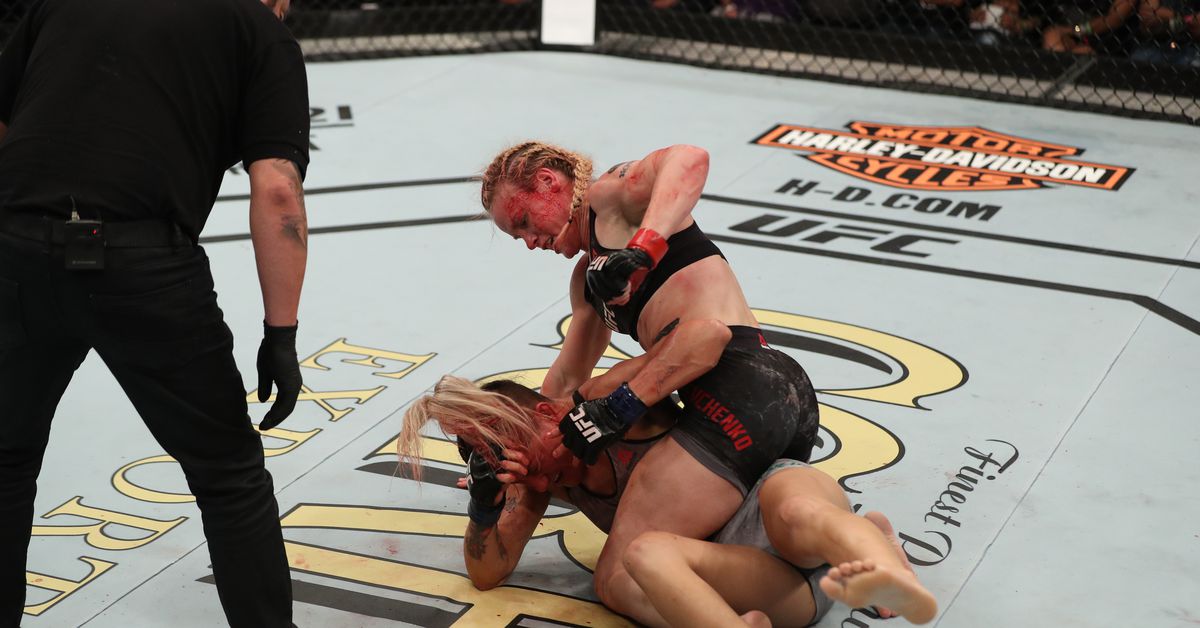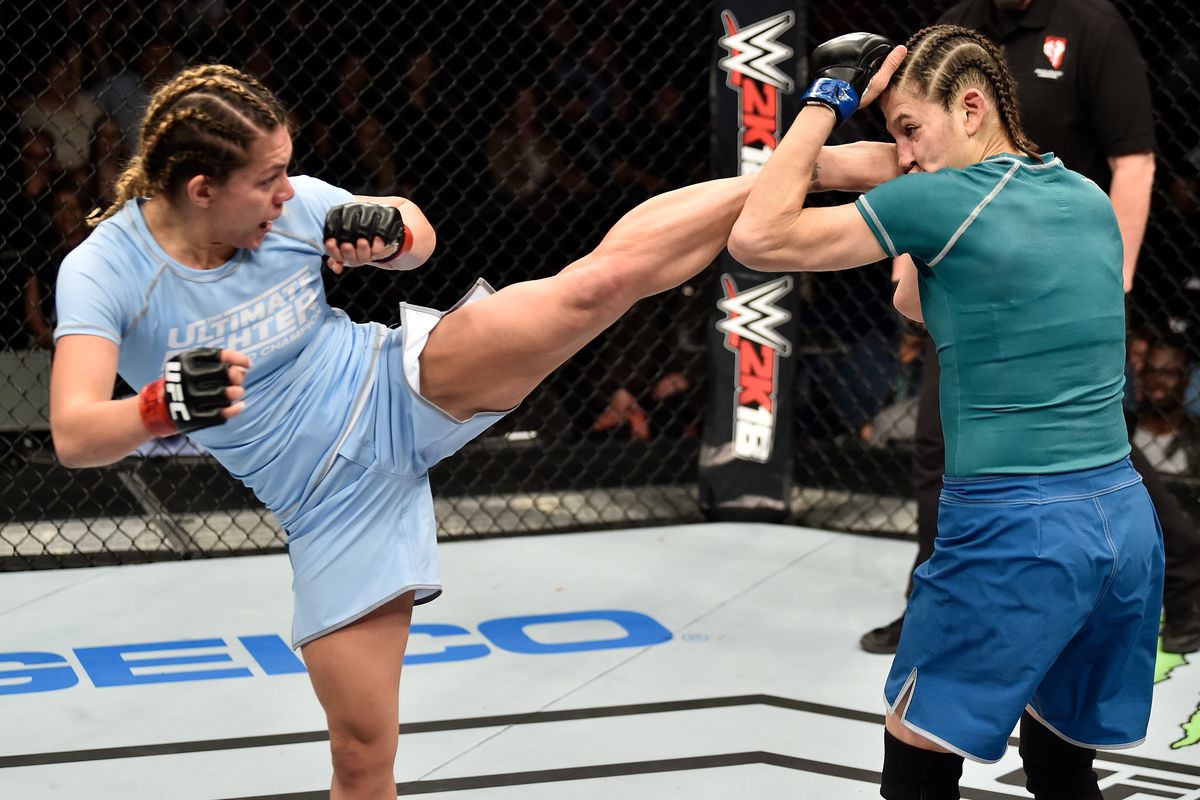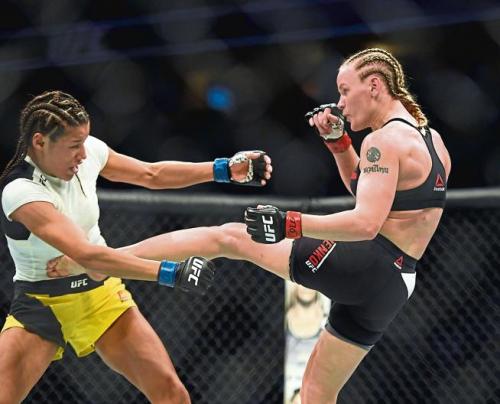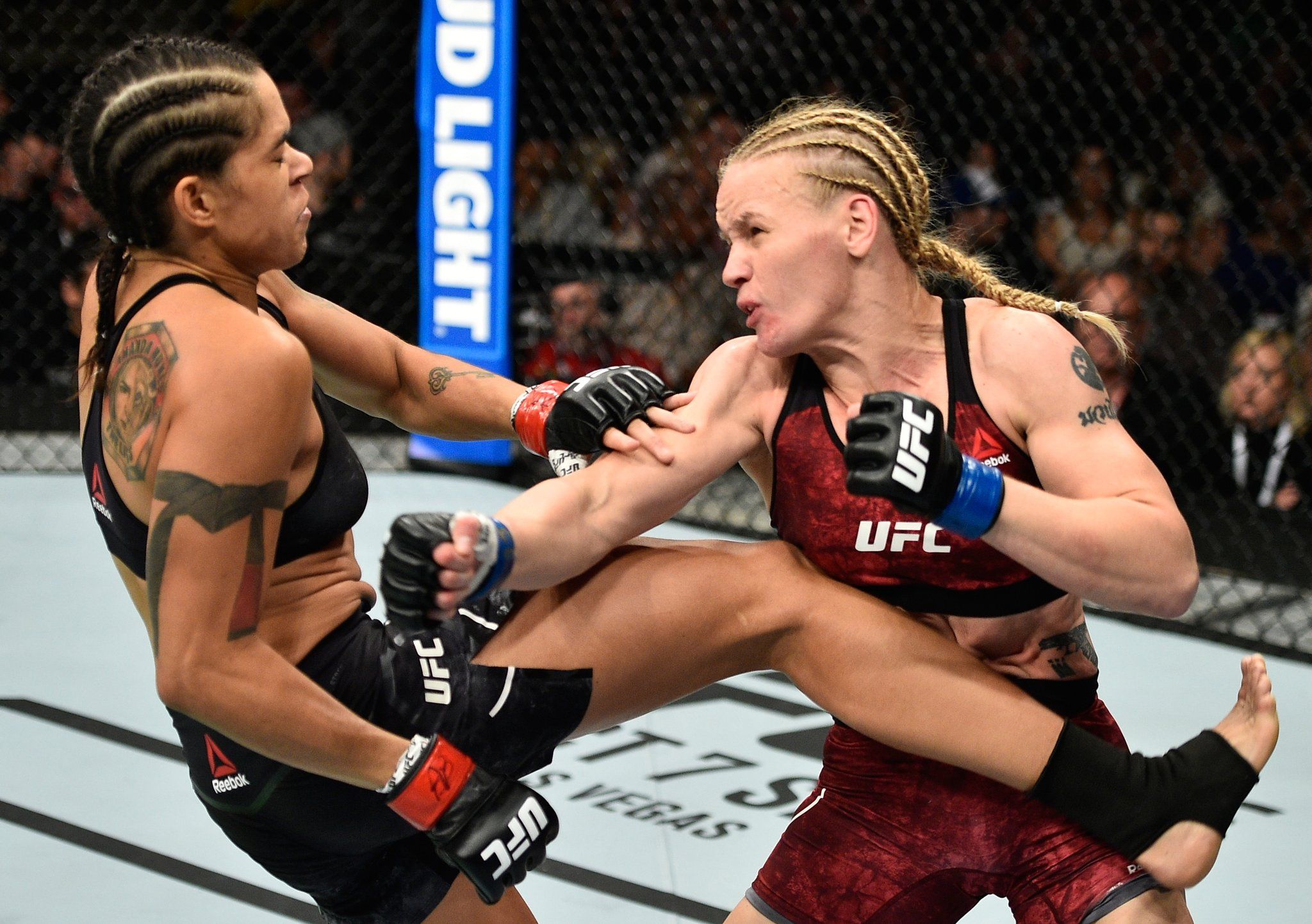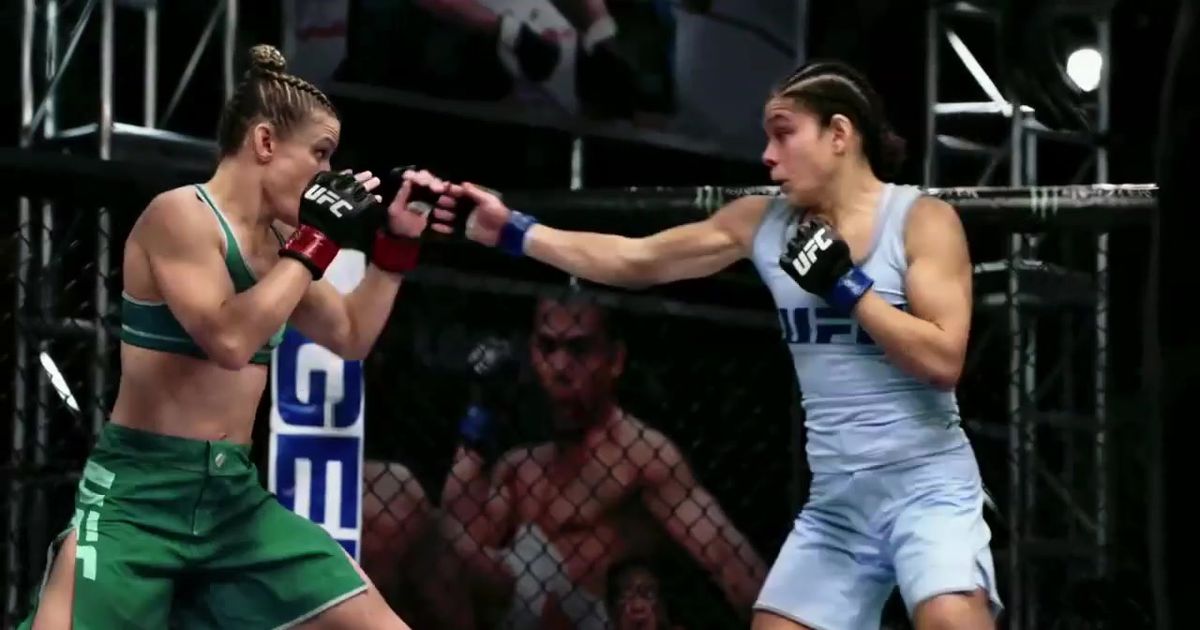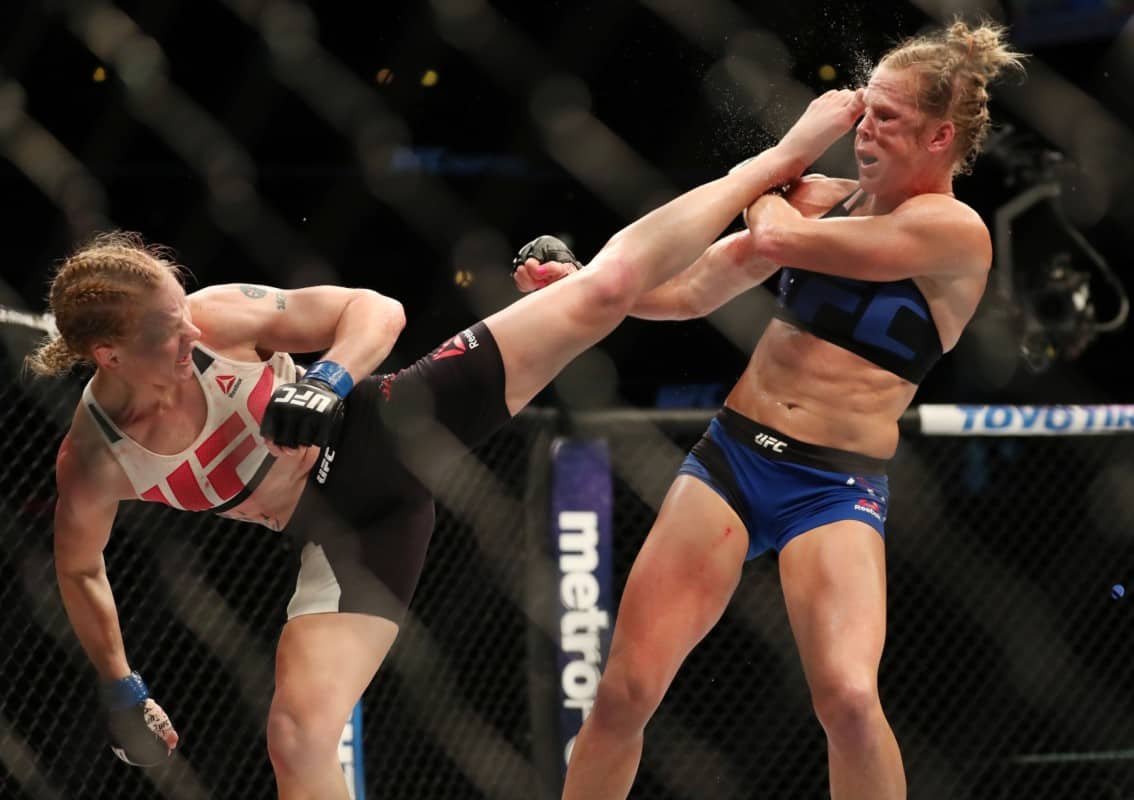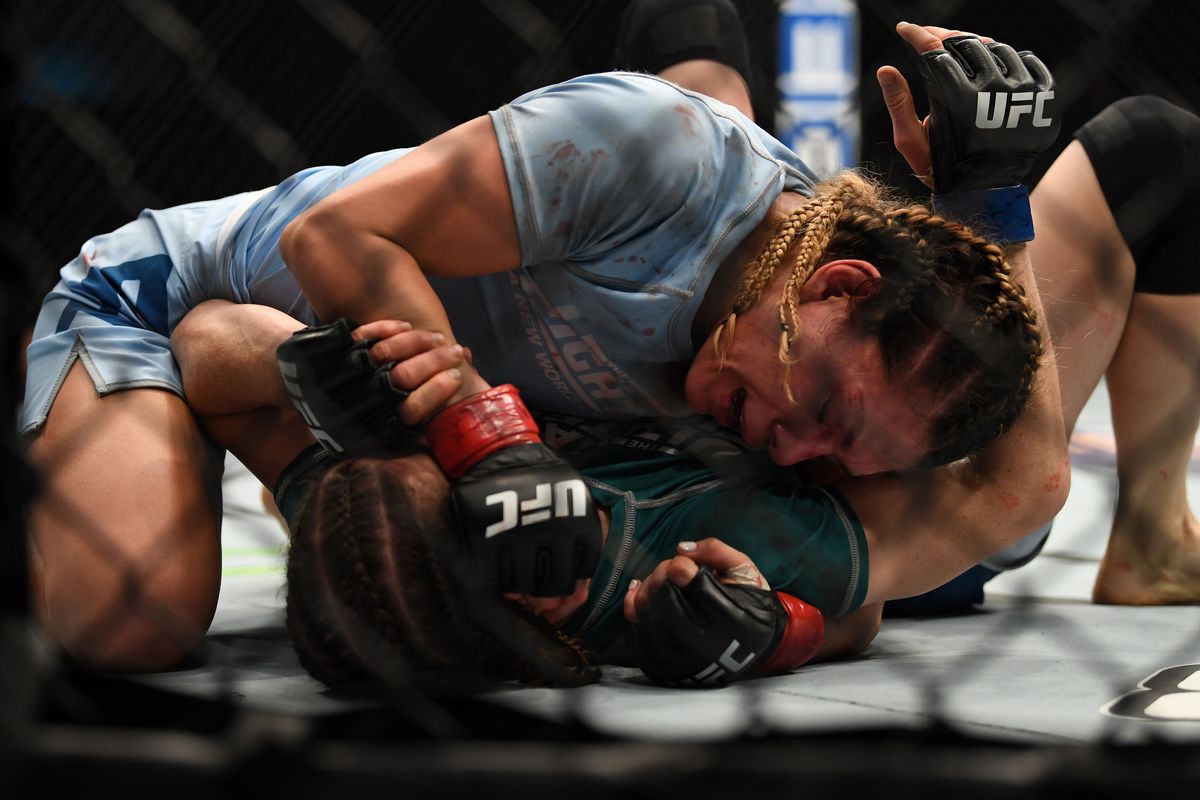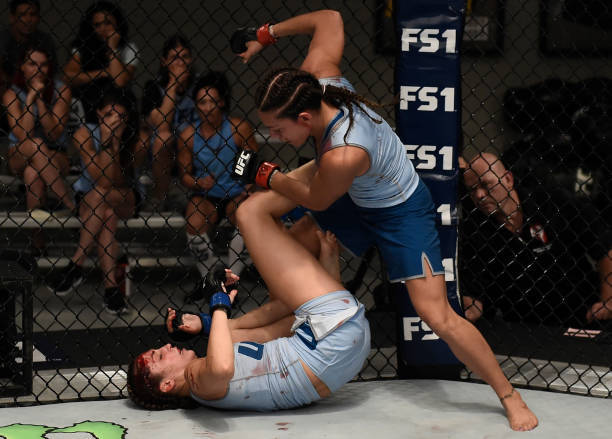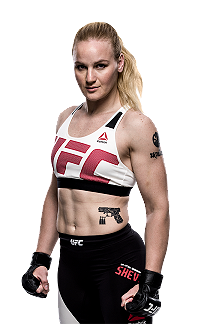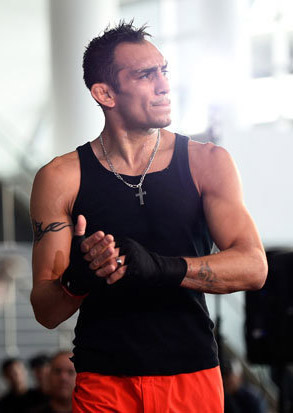Valentina Shevchenko is on the eve of a title fight, her second in the Ultimate Fighting Championship in her second weight class. The first title fight was well deserved, as she beat current Invicta Bantamweight Champion and former Strikeforce Bantamweight Champion Sarah Kaufman, former Legacy FC and UFC Bantamweight Champion Holly Holm, and TUF winner and top five bantamweight Julianna Peña, with a very disputed loss to UFC Bantamweight Champion Amanda Nunes as her Octagon record’s only blemish. Shevchenko showed world class striking, poise, precision, and a burgeoning ground game en route to challenging for Nunes’ title.
At flyweight, however, the story has changed. Shevchenko entered the division angling for a fight with Paige VanZant before being gifted with Priscila Cachoeira, the teammate of top ranked strawweight Jessica Andrade. As expected, Shevchenko dominated, outworking, outclassing, and outfighting Cachoeira on the way to a decisive stoppage win. This “earned” her the position of number one contender and challenger to the title held by current UFC Strawweight Champion and FIT NHB product Nicco Montaño. This Saturday at UFC 228, the inaugural champion Montaño faces the former top ranked bantamweight and currently “top” ranked flyweight Shevchenko, and in this piece I take a look at both fighters and discuss the three reasons why Montaño is a dangerous fight for Shevchenko.
1. Level of Opposition
When discussing the fight, a lot has been made of Shevchenko’s elite performance at the highest levels of mixed martial arts. Shevchenko’s name wins are Jan Finney, Kaufman, Holm, and Peña, but none of those fighters were on win streaks when Shevchenko defeated them, and none of them are particularly diverse in regard to their overall mixed martial arts games. Only two (Finney and Kaufman) were really established veterans, and both of those fighters weren’t ascending in regards to their physical skills or their places in mixed martial arts — at best they were plateauing and at worst they were declining, as both were coming off of decisive losses.
And as for the two other “name” wins, Holm, for all of her accomplishments and athleticism, was still a one-dimensional fighter who relied on athleticism and activity more than any real world class or diverse skills; this also describes Peña, who for all her swagger and confidence was both unrefined and unproven against elite fighters, much less fighters on win streaks. So when you take a close look at Shevchenko’s opposition, they may be great names, but not many of them were great or well-rounded fighters at the time she beat them. The only “great” fighter she faced, she lost to twice. Both were close, but all of Shevchenko’s fights are close for the most part; that’s a result of her style and skill set.
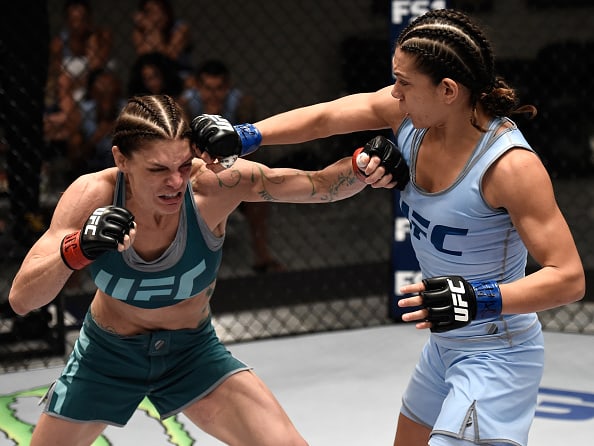 In comparing Montaño’s resume to that of Shevchenko, if you are only talking actual fights in the UFC, there may be some credence to the idea that the challenger’s is vastly superior. But if you count TUF — and seeing as how the two seasons of the show that focused exclusively on women had a direct impact on the rankings of the women’s divisions it ushered in, meaning those fights had weight — Montaño’s opposition in the TUF house at the highest levels isn’t that much different from the biggest and best wins Shevchenko has had.
In comparing Montaño’s resume to that of Shevchenko, if you are only talking actual fights in the UFC, there may be some credence to the idea that the challenger’s is vastly superior. But if you count TUF — and seeing as how the two seasons of the show that focused exclusively on women had a direct impact on the rankings of the women’s divisions it ushered in, meaning those fights had weight — Montaño’s opposition in the TUF house at the highest levels isn’t that much different from the biggest and best wins Shevchenko has had.
Of the biggest wins on Montaño’s resume, Murphy would be the closest match to Finney, but Lauren Murphy is a multiple-organizational, multiple-weight-class champion who has beaten accomplished, name fighters. At that point, Murphy only really lost to former title challengers Liz Carmouche, Sara McMann, and former two-division CFFC Champion Katlyn Chookagian. Barb Honchak would be the best athlete Montaño has faced and would be the closest thing to Holm, as both were at one point the best fighter in their respective divisions and pound-for-pound one of the best women in the world. (Remember, Honchak was the Invicta flyweight champion and only wasn’t in the UFC because the division didn’t exist.) The difference between Holm and Honchak, however, is Barb Honchak was a multi-dimensional fighter who had beaten a who’s who of opponents on her way to her position, something that even the staunchest Holm supporter can’t say. Julianna Peña was more experienced against better opposition, but I don’t know that she is a better athlete than her counterpart Montana De La Rosa, nor do I know that she is a better grappler than De La Rosa. I do know she isn’t more accomplished, as De La Rosa has been the champion of an organization, and I know Peña has fewer fights than De La Rosa. Peña may have won TUF, but the level of competition was neither very talented nor accomplished.
This leaves Kaufman in comparison to Roxanne Modafferi. Neither are elite athletes, but both are extensively accomplished fighters, having won multiple titles in multiple organizations. However, when Montaño faced Modafferi she was facing an opponent who was one of the top 3 or 4 flyweights in the world, having recently defeated a number of high level opponents. Modafferi had also firmly established and expanded upon her skillset — not only was she one of the better grapplers in MMA, but now she had fleshed out and showcased much improved striking. In the context of mixed martial arts, Modafferi is a much better grappler than Kaufman is a striker, and a much better striker than Kaufman is a grappler. So when you look closely at the best women both fighters have beaten, the argument for Shevchenko’s advantage in experience and skill development through fights becomes a lot less sturdy.
2. Creativity/Variation in Strategy
Valentina Shevchenko may in fact be a world class fighter in the world of mixed martial arts. How she has accomplished this is simple: First, she navigates distance using her ability to manipulate range to keep her opponents from getting into the spots they require to be (safely) offensive. As a result of their constant adjustment and readjustment, they are unable to get into a rhythm that would allow them to put shots together, or force Shevchenko into extended striking or wrestling exchanges. This also slows the pace of the fight, which puts a spotlight on the shoddy offensive, counter, and defensive striking of the majority of fighters in mixed martial arts. Shevchenko can essentially pick them apart, as they become increasingly obvious, frustrated with their inability to achieve sustained success.
The other thing Shevchenko does is work a very technical and aggressive clinch, which also scares off opposition from trying to force a pace or impose themselves on her physically. She can unbalance them to open up opportunities to strike from the clinch, or hit various trips and throws to take them down and work them over. But the whole of her approach is built around creating situations where Shevchenko can do three things: dictate pace, dictate space and counter.
At her core, Shevchenko has been and continues to be a counterpuncher. If you have seen one Valentina Shevchenko fight you have seen them all — whether in kickboxing or mixed martial arts, Shevchenko is bolstered and restrained by her dependency on the counter. On the plus it has allowed her to neutralize activity and athleticism (Holm), neutralize explosiveness and size (Nunes), neutralize physicality/aggression (Cachoeira and Peña), and neutralize veteran savvy, activity, and physicality (Kaufman). On the opposite end of the spectrum, it has limited her, as in the two fights with Nunes she was able to limit the amount and effectiveness of her opponent’s explosive and fight-ending offense, but in neither fight was she able to do enough in regards to workrate, impact, or pace to score the win.
Unlike Shevchenko, Montaño has shown variation in her strategy. Whereas Shevchenko has managed to apply a singular strategy and make it successful against a variety of strategies, levels of experience, and skill sets, which shows that what she does is truly effective at a world class level, it also shows a lack of innovation and creativity. In layman’s terms, it’s predictable, and that predictability cost her in the biggest spot of her career. Montaño, in the biggest spots of her career, against the best opponents in her career, was not only able to win, but win against a variety of styles, skills, and levels of experience. And most importantly, she was able to do so in a variety of ways.
Against Murphy, Montaño used footwork, feints, and takedown defense to outposition her opponent, peppering her with long range weapons, then punishing her off failed takedown attempts en route to a clear decision win over the UFC veteran. Against De La Rosa, Montaño willingly exchanged with her, backed her up, and used clinches to beat her up, bully her, then outgrapple her. Against Honchak, an established and seasoned veteran, Montaño outsmarted her opponent, alternating between being safety first with counters, and forcing exchanges at clinch, pocket, and long range. On top of that, Montaño managed to use an unpredictable and balanced mixed martial arts game, turning takedown attempts into scrambles for submission attempts, striking her way into clinches and setting the table for her own takedown attempts. And in her biggest fight with the most on the line, against her most skilled, most experienced, and most accomplished opponent, Montaño not only showed a different approach to start, but also made adjustments within the fight which allowed her take control, navigate rough waters when Modafferi came on, and slowly regain then maintain control of the fight. Whether it was pressuring, countering, throwing volume, or potshotting, Montaño did it, unbalancing and overwhelming the seasoned but athletically and technically limited fighter in Modafferi.
3. Lack of Balance of Skills
Valentina Shevchenko is a world class striker, having won multiple gold medals in the IFMA, a gold medal in the World Combat Sports Muay Thai Championship, and a WAKO world championship, which are just a few of the titles that stood out among a litany of titles in numerous organizations. On top of that, Shevchenko has multiple masters of sports in Muay Thai, Boxing, Kickboxing and Taekwondo — she even has a master of sport in Judo. When it comes to striking, few women in mixed martial arts have tenure, resume, accomplishments, and skills comparable to what Shevchenko possesses. She dictates range and pace using an accurate, well-timed jab mixed in with a stinging inside leg kick. She uses a counter right hook to dissuade bull rushes or entries for clinches; she also uses clinch attempts to rein in her opponents’ attempts at combination punching.
Shevchenko’s most dangerous weapon is her straight left hand; much like former UFC Lightweight Champion Conor McGregor, she uses a variety of tools to create openings to land it, or create opportunities to run an opponent into it. But much like all of her other tools, Shevchenko tends to throw in ones and twos, not threes, fours, and fives. This makes her a very efficient fighter, but not a particularly intimidating or devastating one.
In the clinch, Shevchenko is surgical, as she can neutralize superior grapplers, wrestlers, or just outright bigger fighters with her positioning and pinpoint knees, elbows, and short punches. But on the ground, Shevchenko is basic at best, with a functional understanding of passes, control, guardwork, sweeps, and submissions, which highlights the point of this part of the article. Shevchenko, while world class as a mixed martial artist, is not only one note in her approach, but one-dimensional in the tools that she can use consistently and effectively.
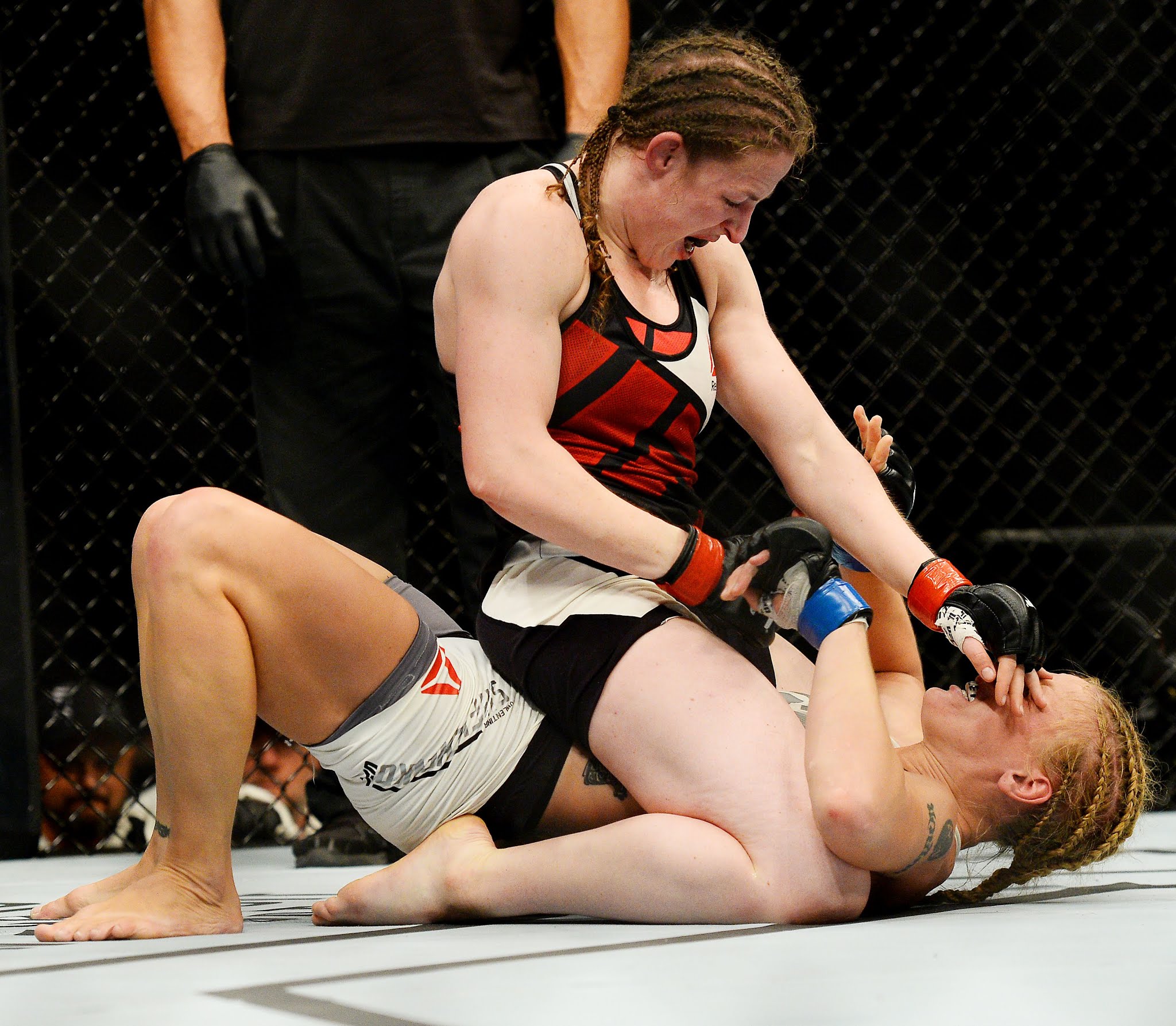 Whether offensively, defensively, or on the counter, Shevchenko has been painfully one-dimensional at the highest level. While she has shown herself capable of hitting trips and throws, her ability to do so is very much connected to her ability to control pace and place through her counters and her defensive footwork. That is what shores up her takedown defense and her ability to hold her own in striking and wrestling exchanges on the feet. However, when forced to spend an extended period of time in wrestling or grappling exchanges, she hasn’t been able to do anywhere near the amount of work in regard to control or submissions that she has shown in those brief exchanges on the feet.
Whether offensively, defensively, or on the counter, Shevchenko has been painfully one-dimensional at the highest level. While she has shown herself capable of hitting trips and throws, her ability to do so is very much connected to her ability to control pace and place through her counters and her defensive footwork. That is what shores up her takedown defense and her ability to hold her own in striking and wrestling exchanges on the feet. However, when forced to spend an extended period of time in wrestling or grappling exchanges, she hasn’t been able to do anywhere near the amount of work in regard to control or submissions that she has shown in those brief exchanges on the feet.
Shevchenko had trouble taking down and controlling Kaufman on the ground, and more importantly, she was taken down and controlled for extended periods of time. Against Holm, Shevchenko got takedowns, but more times than not she wasn’t able to keep Holm down or really get into position to threaten with a submission. And in her two fights with Nunes, she was really only able to get her down and keep her down once. And in that one instance, when Nunes was completely gassed and on the defensive, Shevchenko could neither overwhelm her with strikes nor get into a position where she could finish her.
Montaño, on the other hand, as a result of her team at FIT NHB, has shown a variety of skills. This has given her the technical foundation to be creative in how she fights, as her balance of skills affords her more freedom in where she fights, how she gets there, and how long she stays there. Montaño has the footwork to enter and exit on angles, which allows her to cut down the cage when pressuring and get off the line in order to outposition opponents who seek to put volume on her, or at least put power shots together. Montaño also has the balanced and diversified range of strikes necessary to bridge distance, maintain distance, or mix up enough strikes to unbalance opponents and disrupt their rhythm.
Montaño’s wrestling allows her to pressure opponents, using her ability to defend takedowns, create scrambles to enter into extended grappling exchanges, and counter off takedown attempts. Her ability to initiate her own takedowns also helps, as opponents can’t ward her off with strikes because she can change levels on reactive takedowns when an opponent overextends. Or when an opponent overpursues, she can cut an angle, then hit a reactive takedown.
But what really allows Montaño freedom in her striking and her wrestling — whether attacking, defending, or countering — is her ability to engage in extended grappling exchanges with high level grapplers. Whether fighting from top position, where she has shown a preternatural ability to apply pressure and maintain control, or in a transitional position, where she has shown the ability to create scrambles to gain control, hunt for subs, or get back to her feet, or when she is taken down, Montaño has shown a poise in establishing control, threatening with submissions, and creating opportunities to get back to her feet. This range of skills and balance in these various scenarios has allowed her to navigate the field of much more seasoned, much more accomplished, and to some extent, much more skilled fighters. Montaño has shown the ability to neutralize their strengths and exploit multiple holes in their respective MMA games.
She used airtight takedown defense, long range strikes, counters, and defensive footwork to outposition, outclass, and dismantle Murphy. Against De La Rosa, Montaño used physical and punishing clinch work, takedowns, ground and pound, and positioning to beat up and bully her. Against Honchak she used reactive takedowns, offensive takedowns, range striking, and clinch work to outhustle and wear down the former Invicta champion. And in the title fight against Modafferi, Montaño used punch-kick combinations, aggressive clinch work, offensive takedowns, reactive takedowns, top control, scrambles, leads and counters, pressure footwork and defensive footwork, head kicks, body kicks, leg kicks, and so on. The point is, in multiple fights Montaño has shown a variety of skills defensively, offensively, and on the counter. More importantly, she has shown the ability to match her opponents in areas they excel in, not just beat them in areas they don’t, which is essentially what Valentina Shevchenko has done in her run in the UFC.
I would never say Shevchenko can’t win this fight — she has more fights than Montaño, she is a clearly more established and accomplished striker, and she has been proven in “real” mixed martial arts fights against very good, very accomplished, “big name” mixed martial artists. She has also faced the bigger and better athletes. But Shevchenko is far from perfect. If she were the fighter that they make her out to be, she would be the current UFC Bantamweight Champion, dropping weight to challenge for the flyweight title, or defending against Montaño’s challenge as she stepped up to bantamweight. But the fact of the matter is that her predictability in how she fights, as well as her lack of depth in regards to her all-around skills, has limited her immensely in the nature of her fights and the results she has gotten in the biggest spots in her career.
To act as if Nicco Montaño has no way to win, no set of tools that could put Valentina Shevchenko in danger, and no sort of ability to adjust to the styles presented to her as an obstacle, or to work through adversity to find success, is to vastly underrate her chances at UFC 228. On the biggest stages, versus the best opposition, Montaño has shown this, repeatedly. It may be rough, it may not be refined, it may have its limitations based on the brevity of her career and her inactivity as a whole. But that doesn’t mean the foundation isn’t there, the talent isn’t there, and the tools aren’t there. They are, and if Montaño can put them together one more time on Saturday night, she can walk away from the Octagon as a successfully defending champion.
• Nicco Montano vs. Valentina Shevchenko (UFC Women’s Flyweight Championship)
UFC 228: Woodley vs. Till takes place September 8, 2018 at American Airlines Arena in Dallas, Texas.
Click HERE for more UFC 228 Post-Fight Analysis


